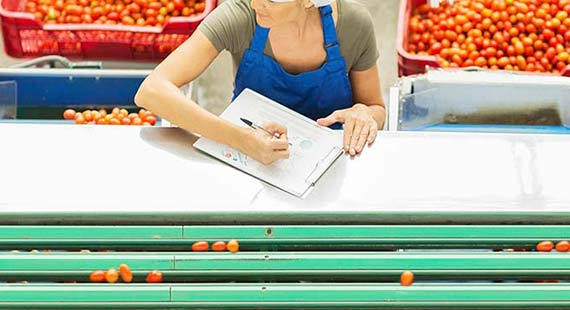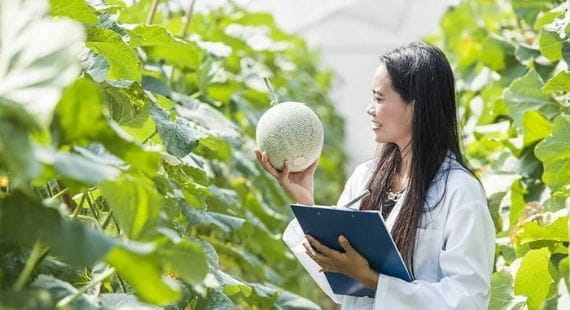
Four global trends that will start a food revolution
Four global trends that will start a food revolution
"New food production ways and choices will be reality for us in the near future, but the responsibility of consumer safety is still the same."
Dr. Ron Wacker
Global Business Unit Manager of Food, Health and Beauty, TÜV SÜD
Wednesday, February 7, 2018
What if we could do away with consuming farm-raised animals and instead eat insect-based protein or in vitro meat? What if we could stack farms atop each other and automate them with robots? Or blend cutting-edge hydroponics technology with advanced fish farming systems? Scientists say we may be on the verge of doing all the above – with 2018 shaping up to be a key year for the food trade.
Did you know: to produce a single kilogram (kg) of beef, a farmer needs 10kg of animal feed? That same 10kg can also nourish 10kg of grasshoppers. This data is no mere curio for trivia fans or zoologists – it could be vital information for the farmers, politicians and food scientists of tomorrow.
Per the Worldwatch Institute, global meat production has tripled over the last four decades and increased 20 percent in the last 10 years, putting serious strains not only on farmers, but also on the environment. The meat industry is one of the world’s biggest pollutants, and health scares like BSE or commonly known as “mad cow disease”, bird flu and swine flu have done nothing to help its cause.
So, could farmers of the future instead turn to the much-neglected insect world in their search for sustainable, environment-friendly animal protein? The idea is less fanciful than it may sound. In fact, insect protein is just one of four major trends that could change the way the world eats in 2025 – and beyond.
Take a look at the video below to discover the four trends that will start a food revolution:
As the world’s population grows, space is now at a premium everywhere. Agriculture accounts for over 37 percent of the world’s land area. If farming does not change fast, food security is at risk. Fortunately, innovators have come up with a solution: vertical farms.
This involves stacking rows and rows of crops on top of one another, rather than using limited ground space, in an advance move that builds on successful soil-free hydroponics models. What is more, using automation technology like robotics and IoT, scientists claim that a single 2,790sqm facility could produce 1.5 million tons of crops a year.
Automation and stacking mean that such farms could operate with unprecedented efficiency, producing 80 percent less food waste. Operating twice as fast as conventional farms, with a power usage rate of just 60 percent of a regular farm, automated vertical farms would also use less resources than an outdoor field – a staggering 99 percent less water.
Water usage is a major issue for farmers everywhere. Per the OECD, “farming accounts for around 70 percent of the water used in the world today, and also contributes to water pollution from excess nutrients, pesticides and other pollutants.”
Once again, science is on hand to help out. The use of aquaponics is becoming more widespread. The fish-and-farming technique incorporates hydroponics principles, but there are two goals: to produce fish as well as large quantities of crops.
With aquaponics initiatives, like one pioneering project at a special school in Trinidad, a virtuous cycle is created for the aquatic environment in tanks. Here, the fish convert their food into nutrients that plants can actually absorb, and these plants then go on to clean the water for the fish.
A farmer could thus expect to harvest twice as many heads of a crop, like lettuce, from an aquaponics farm. They could also produce a very significant amount of fish, while using about half of as much water as a conventional lettuce farm.
Mankind has long relied on rearing large herbivores for its protein needs. But with the global meat industry now one of the environment’s biggest polluters, many scientists say that the time has come to look elsewhere.
Their search has led them to insects. Not only are insects efficient to produce, they are also extremely healthy. They require only a fraction of resources compared to producing beef and emit a mere 9 percent as much carbon dioxide. A single kilogram of termites, for instance provides about 350g of protein. The same quantity of beef contains just 320g.
Insects have been eaten since the dawn of civilisation, and many cultures still dine on them today. Adopting them into the modern diet could greatly help in the fight against both world hunger and global warming. As pioneering cooks and food producers in the West begin experimenting with insect bread and more, expect to find more food manufacturers using insects in their produce in the year ahead.
Cultivating meat in laboratories was once part of science fiction. But now researchers say that in-vitro meat sources might replace costly, environment-polluting livestock farms altogether.
Cattle and pigs famously consume vast quantities of water. In fact, a recent report claimed that a mere 453g of beef requires almost 7,000 litres of water. In-vitro meat sources can help do away with livestock farms altogether. Instead, scientists can cultivate and feed self-replicating muscle tissue cultures in safe environments, removing the need for rearing and slaughtering live animals.
According to studies, the general public is already warming to the idea of in-vitro meat – with over 70 percent of customers saying they would like to try lab-grown beef.
And per Dr. Ron Wacker, TÜV SÜD’s Global Manager of Food, Health and Beauty, market forces may soon bring in-vitro meat to a supermarket shelf near you. He says, “If a lab-grown steak is available at half of the price of a conventionally produced cut, you can be sure that it will find its way to consumers’ tables. Furthermore, lab-grown meat contains the same level of nutrition and is even safer as it is produced in a controlled environment.”
Time does not stand still in the fast-moving world of food production, and these four food trends might soon become commonplace. However, as with all innovations in the sensitive world of human diets, safety must come first – and regulators will have an increasingly important role to play.
Dr. Wacker notes, “As newer alternatives to traditional farming methods become available, regulatory bodies need to stay up-to-date and strike a balance. They need to be aware of new safety concerns, but also avoid restricting potentially revolutionary new opportunities for the food production industry.”
Technological advances always bring new risks with them, as well as opportunities – especially in the case of food. Says Dr. Wacker, “Staying up-to-date with modern technology’s pros and cons, and verifying its safety for consumers has been key to TÜV SÜD’s vision for over 150 years.”
Stay up-to-date with the latest news on Food and Health safety here.


Satisfy your appetite for business and consumer insights
Learn more

Site Selector
Global
Americas
Asia
Europe
Middle East and Africa